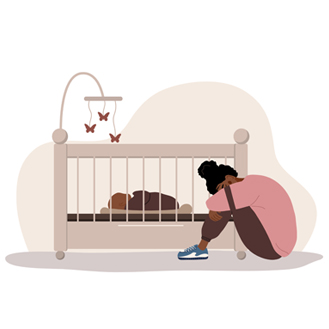
This article includes discussion of postpartum depression that may be challenging for some readers.
January 16, 2024
By Ugo Uguru, Drexel University College of Medicine
Many mothers would agree that the process of childbirth is not an easy experience. The body goes through physical, psychological and emotional changes. One of the most common problems that women face after childbirth is postpartum depression (PPD). The negative impact of postpartum depression is responsible for approximately 20% of suicide-related postpartum death and significantly affects mother-to-child bonding.3
According to the American College of Obstetricians and Gynecologists, PPD is an intense feeling of sadness, anxiety or despair in women after childbirth that interferes with daily tasks.4 This should be differentiated from postpartum blues, which presents with less severe but similar symptoms as PPD and starts anytime from two to three days after childbirth, but resolves in less than two weeks without any treatment. On the other hand, PPD is diagnosed when the symptoms persist at least for two weeks within six weeks after delivery and may last from months to years. These symptoms may manifest as lack of interest in daily activities, difficulty concentrating, loss of appetite, fear of injury, excessive worries and concerns for the baby, insomnia or hypersomnia, depressed mood, weight change, suicidal ideation or attempt, or feelings of hopelessness. This is very similar to symptoms of major depressive disorder (MDD) because PPD is a subtype of MDD.
The cause of PPD is not fully understood, but some studies have associated epigenetic and neuroendocrine changes during pregnancy with development of mood disorder. For example, low prolactin levels have been shown to be associated with higher risk of postpartum depression, suggesting decreased lactation can be detrimental to mental health.5 While there have been several propositions on the causes of PPD, the data supporting some of these claims have been largely inconsistent, and therefore require further research.3 Some other risk factors include but are not limited to:1
- Previous history of depression and anxiety
- Domestic abuse
- Premenstrual syndrome
- High-risk pregnancies including emergency cesarean section and hospitalization
- Postpartum complication such as umbilical cord prolapse, hemorrhages, etc.
- Mother of infants with low birthweight
- Lack of support through course of pregnancy
- Domestic abuse
- Smoking
- Lack of exercise
- Unhealthy eating habits
- Poor sleep cycle
While evaluating a new mother for PPD, it is important to take a social history including drug and alcohol use, smoking history and medication use, as these may interfere with accurate diagnoses of PPD. Screening begins as early as the first postnatal obstetrical visit. Several screening tools are available, but most frequently used is the Edinburgh Postnatal Depression Scale, which is a 10-item questionnaire completed by patient during visit.2 A score cutoff equal or greater than 13 requires further evaluation as it indicates increased risk for PPD. In treatment of PPD, psychotherapy is the first line treatment for mild to moderate depression; however, in some cases a combination of psychotherapy and antidepressants are used, especially in patients with moderate to severe symptoms. Selective serotonin receptor inhibitors (SSRI) are commonly prescribed for PPD. Serotonin and norepinephrine reuptake inhibitors may also be used if SSRI is infective. Treatment should be continued for six to 12 months to prevent relapse. Other treatments include repetitive transcranial magnetic stimulation, which is a non-invasive procedure that uses magnetic waves to activate nerve cells.2 This can be an alternative for mothers who refuse medication treatment, but poses risk of side effects such as headache, scalp and facial discomfort, and muscle twitching.2 If a mother is having severe symptoms including suicidal intent and starvation, or is refractory to psychotherapy and pharmacotherapy, electroconvulsive therapy is recommended.
Drexel's Employee Assistance Program is available to help employees in need of support through confidential, 24/7 counseling at 888.628.4824. This is offered at no cost to benefits-eligible faculty and professional staff, their family members, and Drexel graduate students. More information is available on the Human Resources website. Students can reach out for support via Student Wellbeing.
Sources/Resources:
- Ghaedrahmati, M., Kazemi, A., Kheirabadi, G., Ebrahimi, A., & Bahrami, M. (2017). Postpartum depression risk factors: A narrative review. Journal of education and health promotion, 6, 60. https://doi.org/10.4103/jehp.jehp_9_16
- Mughal, S., Azhar, Y., Siddiqui, W., (2022). Postpartum Depression. Available from: https://www.ncbi.nlm.nih.gov/books/NBK519070/
- Payne, J. L., & Maguire, J. (2019). Pathophysiological mechanisms implicated in postpartum depression. Frontiers in neuroendocrinology, 52, 165–180. https://doi.org/10.1016/j.yfrne.2018.12.001
- Postpartum depression. (2021). The American College of Obstetricians and Gynecologists. Retrieved January 27, 2023, from https://www.acog.org/womens-health/faqs/postpartum-depression
- Stuebe, AM., Grewen, K., Pedersen, CA., Propper, C., & Meltzer-Brody S., (2012). Failed Lactation and Perinatal Depression: Common Problems with Shared Neuroendocrine Mechanisms? Journal of Women’s Health 21 (2012) 264–272.